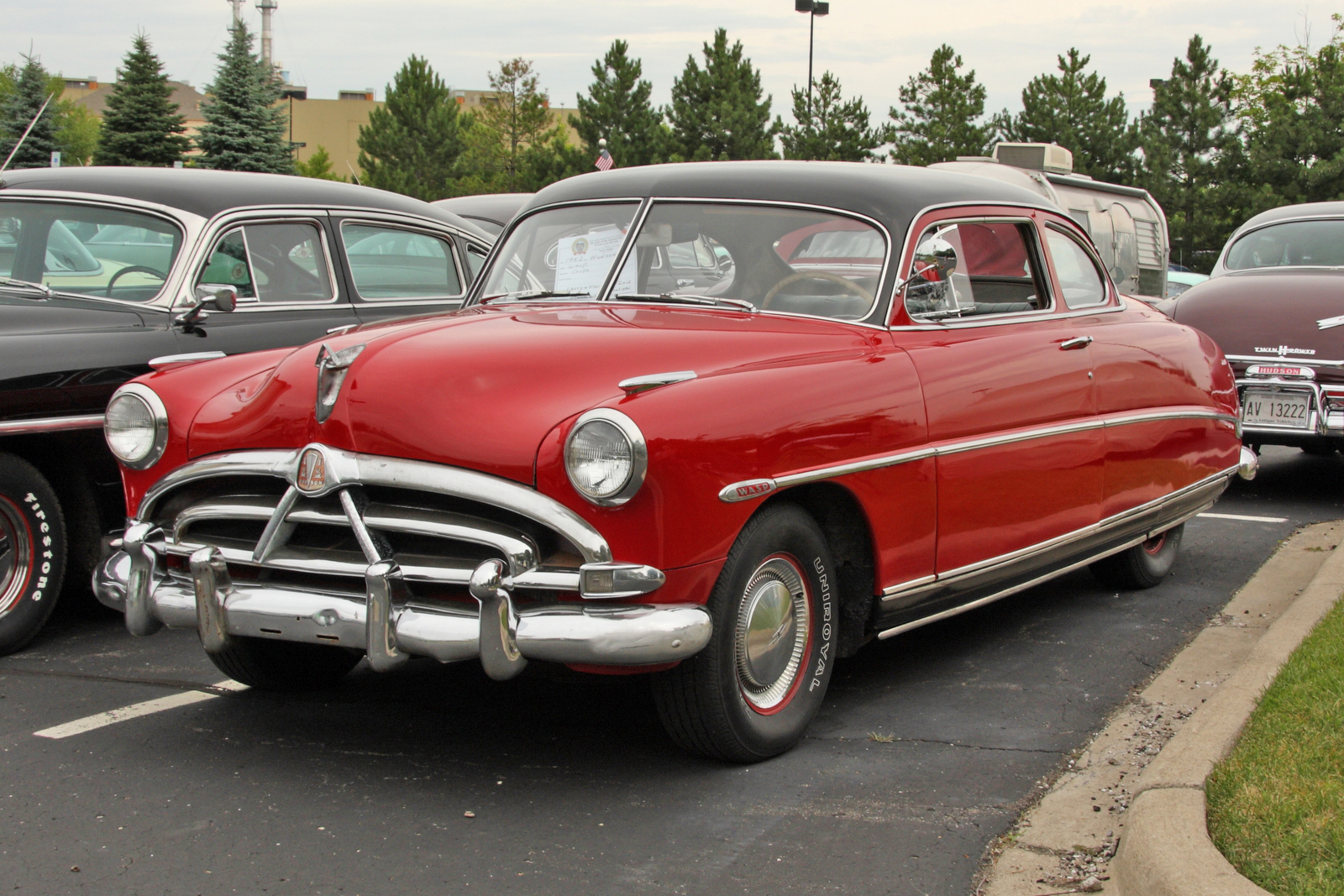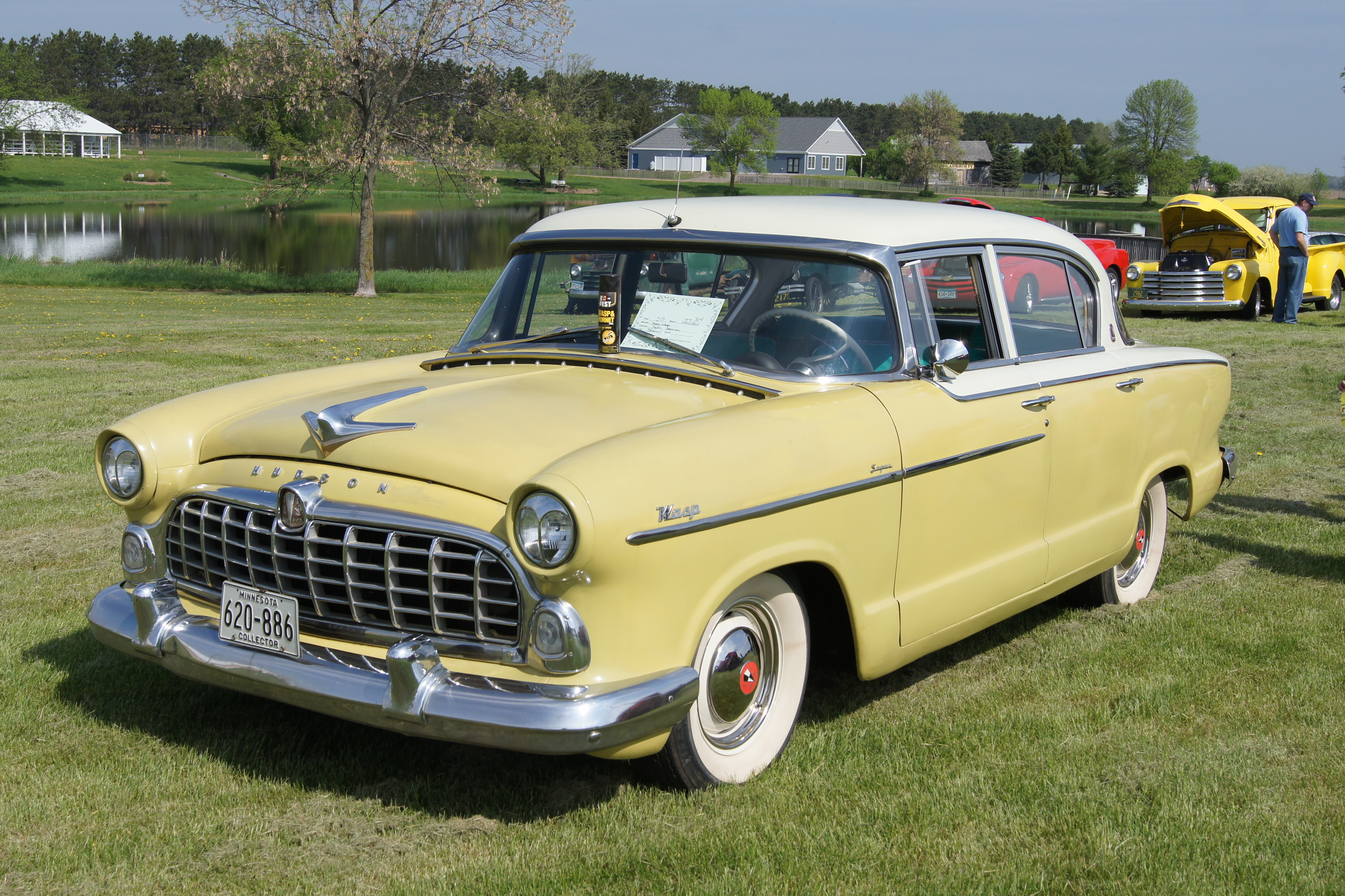Hudson Wasp on:
[Wikipedia]
[Google]
[Amazon]
The Hudson Wasp is an automobile that was built and marketed by the



 The Wasp (Series 58) was introduced by Hudson for the 1952 model year as an upgraded version of the Hudson Pacemaker, replacing the
The Wasp (Series 58) was introduced by Hudson for the 1952 model year as an upgraded version of the Hudson Pacemaker, replacing the
Hudson Car Club
Hudson-Essex-Terraplane Club
{{Amc Timeline
Hudson Motor Car Company
The Hudson Motor Car Company made Hudson and other branded automobiles in Detroit, Michigan, U.S., from 1909 until 1954. In 1954, Hudson merged with Nash-Kelvinator to form American Motors Corporation (AMC). The Hudson name was continued through ...
of Detroit, Michigan
Detroit ( , ; , ) is the largest city in the U.S. state of Michigan. It is also the largest U.S. city on the United States–Canada border, and the seat of government of Wayne County. The City of Detroit had a population of 639,111 at ...
, from the 1952 through the 1956 model years. After Hudson merged with Nash Motors
Nash Motors Company was an American automobile manufacturer based in Kenosha, Wisconsin from 1916 to 1937. From 1937 to 1954, Nash Motors was the automotive division of the Nash-Kelvinator Corporation. Nash production continued from 1954 to 1 ...
, the Wasp was then built by American Motors Corporation
American Motors Corporation (AMC; commonly referred to as American Motors) was an American automobile manufacturing company formed by the merger of Nash-Kelvinator Corporation and Hudson Motor Car Company on May 1, 1954. At the time, it was the ...
in Kenosha, Wisconsin
Kenosha () is a city in the U.S. state of Wisconsin and the seat of Kenosha County. Per the 2020 census, the population was 99,986 which made it the fourth-largest city in Wisconsin. Situated on the southwestern shore of Lake Michigan, Kenos ...
, and marketed under its Hudson marque for model years 1955 and 1956.
The Hudson Wasp can be classified by two distinct model year generations: from 1952 to 1954 when it used Hudson's existing short-wheelbase platform
Platform may refer to:
Technology
* Computing platform, a framework on which applications may be run
* Platform game, a genre of video games
* Car platform, a set of components shared by several vehicle models
* Weapons platform, a system or ...
, and in 1955 and 1956 when it was built on the full-sized Nash platform, with completely different designs for each of these two model years.
Model years
1952–1954



 The Wasp (Series 58) was introduced by Hudson for the 1952 model year as an upgraded version of the Hudson Pacemaker, replacing the
The Wasp (Series 58) was introduced by Hudson for the 1952 model year as an upgraded version of the Hudson Pacemaker, replacing the Hudson Super Custom
Hudson may refer to:
People
* Hudson (given name)
* Hudson (surname)
* Henry Hudson, English explorer
* Hudson (footballer, born 1986), Hudson Fernando Tobias de Carvalho, Brazilian football right-back
* Hudson (footballer, born 1988), Hudson R ...
models from 1951. The Wasp was available in two- and four-door sedan, convertible
A convertible or cabriolet () is a passenger car that can be driven with or without a roof in place. The methods of retracting and storing the roof vary among eras and manufacturers.
A convertible car's design allows an open-air driving expe ...
, and a 2-door hardtop
A hardtop is a rigid form of automobile roof, which for modern cars is typically constructed from metal. A hardtop roof can be either fixed (i.e. not removable), detachable for separate storing or retractable within the vehicle itself.
The ...
designated the Hollywood. The Wasp was built on Hudson's shorter wheelbase
In both road and rail vehicles, the wheelbase is the horizontal distance between the centers of the front and rear wheels. For road vehicles with more than two axles (e.g. some trucks), the wheelbase is the distance between the steering (fron ...
, using the company's unitized, "Monobilt" step-down chassis design with an overall length of . Hudson's unitized structure used a perimeter frame which provided a rigid structure, low center of gravity, and side-impact protection for passengers.
The base Hudson Wasp used the L-Head straight six from the Pacemaker. Hudson also offered the Super Wasp which used improved interior materials and a more powerful Hudson 6-cylinder engine. Instead of using the Pacemaker's straight 6, the Super Wasp used Hudson's L-Head six fed by a single 2-barrel carburetor
A carburetor (also spelled carburettor) is a device used by an internal combustion engine to control and mix air and fuel entering the engine. The primary method of adding fuel to the intake air is through the venturi tube in the main meteri ...
. The engine was rated at (with single 2-barrel carburetor) while the top-of-the-line Commodore Custom Eight's straight 8 was rated at . The six's power was underrated so it would not outshine the flagship straight 8. The narrow block engine was the basis for the stroked and reinforced Hornet 6-cylinder engine, introduced in 1951 which dominated NASCAR
The National Association for Stock Car Auto Racing, LLC (NASCAR) is an American auto racing sanctioning and operating company that is best known for stock car racing. The privately owned company was founded by Bill France Sr. in 1948, and ...
from 1952 to 1954. The Super Wasp was also offered with an aluminum "twin H" manifold and twin 2-barrel carburetors. Super Wasp performance with the "twin H" induction matched the performance of the big 2-barrel equipped, but heavier, Hudson Hornet.
Wasp model year production saw 21,876 units in 1953 and 17,792 units in 1954, its final year before the Hudson merger with Nash-Kelvinator Corporation.
1955
For 1955 the Wasp became a product of the newly formed American Motors Corporation (AMC). Following the end of 1954 model year production, Hudson's Detroit manufacturing facility was closed and assembly of Hudson models was shifted to Nash's factory inKenosha, Wisconsin
Kenosha () is a city in the U.S. state of Wisconsin and the seat of Kenosha County. Per the 2020 census, the population was 99,986 which made it the fourth-largest city in Wisconsin. Situated on the southwestern shore of Lake Michigan, Kenos ...
. All Hudsons would be based on the senior Nash models, but would have exclusive Hudson styling.
After Hudson's 1954 merger with Nash, 1955 Hudsons were built on the unitized Nash platforms. The 1955 Hornet was built on the 1955 Nash Ambassador platform and offered with the big Hornet I6 engine, as well as a detuned V8 engine supplied by Packard
Packard or Packard Motor Car Company was an American luxury automobile company located in Detroit, Michigan. The first Packard automobiles were produced in 1899, and the last Packards were built in South Bend, Indiana in 1958.
One of the "Th ...
. The 1955 Hudson Wasp was built on the Nash Statesman platform. For 1955, the Wasp was offered with Hudson's I6 previously used in the Hudson Jet compact sedan and the Hudson Italia. The was offered with twin H Power and was rated at .
The 1955 Hudsons used Nash's long travel coil spring suspension, integrated and advanced Heating and ventilation system and were offered with air conditioning and reclining seats. Although comfortable, the Nash-based Hudsons were no longer competitive on the race tracks where they dominated from 1952 to 1954.
Hudson Wasp sales dropped to 7,191 units for the year as traditional Hudson buyers left the marque, viewing the cars as something less than the legendary Hudsons of the past.
1956
For the 1956 model year, AMC executives decided to give the Wasp and Hornet more character in hopes of boosting sales. However, the plan backfired. Design for the vehicles was given over to designerRichard Arbib
Richard Henry Arbib (September 1, 1917 in Gloversville, New York – February 22, 1995 in Manhattan, New York City) was an American industrial designer.
He was a design consultant known for working on many products and services. His focus wa ...
, who provided Hudson with one of the more distinctive looks in 1950s, which he called "V-Line Styling". Taking the traditional Hudson triangle, Arbib applied its "V" form in every conceivable manner across the interior and exterior of the car. Arbib's front-end combined a tightly woven egg-crate grille (a nod to the 1931 Hudson Greater Eight
The Hudson Greater Eight is a luxury car that was produced by the Hudson Motor Car Company of Detroit, Michigan during 1931 and 1932.
History
The Hudson Motor Car Company, headed by Roy D. Chapin, developed a reputation and success in the automob ...
) bisected by a prominent "V" (a nod to the 1954 Hudson Italia
The Hudson Italia is an automobile styling study and a limited production two-door compact coupé that was produced by the Hudson Motor Car Company of Detroit, Michigan, in cooperation with Carrozzeria Touring of Italy, and subsequently markete ...
). Combined with tri-tone paint combinations, the Hudson's new look was unique. However, the plan to build a better Hudson identity failed; the car's garish design failed to excite buyers. The Wasp was available only as a four-door sedan and its sales fell to 2,519 units in its final year of production.
End of production
In 1957, AMC stripped Hudson of eleven of its fifteen models, including the Wasp.Australian assembly
The Wasp was assembled inAustralia
Australia, officially the Commonwealth of Australia, is a sovereign country comprising the mainland of the Australian continent, the island of Tasmania, and numerous smaller islands. With an area of , Australia is the largest country by ...
from complete knock down
A knock-down kit (also knockdown kit, knocked-down kit, or simply knockdown or KD) is a collection of parts required to assemble a product. The parts are typically manufactured in one country or region, then exported to another country or region ...
(CKD) kits.
References
* *External links
Hudson Car Club
Hudson-Essex-Terraplane Club
{{Amc Timeline
Wasp
A wasp is any insect of the narrow-waisted suborder Apocrita of the order Hymenoptera which is neither a bee nor an ant; this excludes the broad-waisted sawflies (Symphyta), which look somewhat like wasps, but are in a separate suborder ...
Hudson Wasp
Coupés
Convertibles
Sedans
Rear-wheel-drive vehicles
Cars introduced in 1952
Full-size vehicles